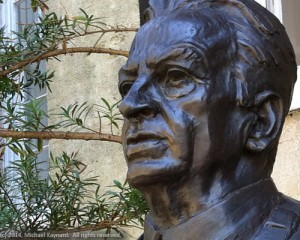This week’s mystery focuses on the top of a South Carolina building. That’s the only clue you get. Send your guess to editor@charlestoncurrents.com with “Mystery Photo” in the subject line. Please make sure to include your name and contact information.
Last issue’s mystery
 The April 23 Mystery Photo, scrubbed by us of the identifying name carved in stone, showed the J. Waites Waring federal courthouse annex near the Four Corners of Law at Meeting and Broad streets. Once named for former U.S. Sen. Fritz Hollings, the retired senator asked a few years ago for his name to be removed so it could honor Waring, a judicial lion ahead of his time with rulings to desegregate the South.
The April 23 Mystery Photo, scrubbed by us of the identifying name carved in stone, showed the J. Waites Waring federal courthouse annex near the Four Corners of Law at Meeting and Broad streets. Once named for former U.S. Sen. Fritz Hollings, the retired senator asked a few years ago for his name to be removed so it could honor Waring, a judicial lion ahead of his time with rulings to desegregate the South.
Congratulations to several eagle-eyed sleuths for correctly identifying the photo: Chris Books of Mount Pleasant; Joe Mendelsohn and James McMahan, both of Charleston; Elizabeth P. Stevens of Mobile, Ala.; George Graf of Palmyra, Va.; Tom Tindall of Edisto Island; Archie Burkel of James island; and Kristina Wheeler of West Ashley.
Graf shared some of the story about Waring, according to SCETV.org: “Perhaps Waring’s most famous legal opinion was a dissent issued in the case of Briggs v. Elliott. Filed on Dec. 22, 1950, by NAACP lawyers on behalf of the parents of black students, Briggs indicted School District 22 with upholding unequal conditions in the black and white schools of Clarendon County, South Carolina. While white students were transported by bus, black students had to walk up to nine miles to reach their schools, since no buses were provided. Conditions inside of black schools lacked indoor plumbing, running water, and were typically heated only by wooden stoves. Attorneys for the plaintiffs argued that separate and segregated schools were unconstitutional.
“Waring, along with Judges Parker and Timmerman, was appointed to the three-judge panel set to hear the case. The plaintiffs lost their case by a 2 to 1 vote, but Waring’s scathing dissent became well publicized. The judge deemed segregation to be “an evil that must be eradicated” and proclaimed, “Segregation is per se inequality.” On appeal, the Supreme Court upheld the original court’s decision in Briggs. That same day Waring announced his retirement.”
Tindall provided more context, based on information from the U.S. General Services Administration:
“The mystery photo is of the J. Waties Waring Judicial Center, located at 83 Meeting Street in Charleston. The J. Waties Waring Judicial Center was constructed in 1988 as an annex building in downtown Charleston’s federal complex. It abuts the 1890s-era U.S. Post Office and Courthouse and was originally named the Hollings Judicial Center in honor of former U.S. Senator Ernest “Fritz” Hollings. The Judicial Center, Post Office, Courthouse and Josiah House constitute one anchor in Charleston’s renowned “Four Corners of the Law,” which is completed by Charleston City Hall, the County Courthouse, and St. Michael’s Episcopal Church.
U.S. Sen. Lindsey Graham and U.S. Rep. James Clyburn introduced legislation renaming the facility at the behest of former Senator “Fritz” Hollings. Public Law 114-48 designating the J. Waties Waring Judicial Center was approved by the U.S. Congress and signed by President Obama in August 2015. The re-dedication ceremony also included a special tribute to the 93-year-old Hollings who served six terms in the U.S. Senate and retired in 2004 as the eighth-longest-serving senator in U.S. history. While in office, Hollings supported civil rights and concentrated on the plight of the poor in South Carolina.
“Charleston native Judge Julius Waties Waring, the son of a Confederate veteran, was nominated to the federal court bench by President Franklin Roosevelt in 1942. He assumed the bulk of the South Carolina U.S. District Court’s civil rights docket and issued landmark rulings on black teacher pay disparities, voter disenfranchisement and school segregation cases.
“Waring’s 1951 Briggs v. Elliott opinion was America’s first federal judicial record to hold that government-mandated segregation violated the Fourteenth Amendment to the U.S. Constitution. Waring asserted that “Segregation is per se inequality.” The U.S. Supreme Court upheld Waring’s dissent and relied on his language and reasoning in casting its unanimous 1954 decision declaring the “separate but equal” doctrine unconstitutional in Brown v. Board of Education, which consolidated Briggs and other school segregation cases. Waring’s challenges to the racially-discriminatory practices of that era came at great personal expense, as he and his family were vilified and received constant death threats. Waring retired from the bench in 1952 and moved to New York City, where he died on Jan. 11, 1968, at age 87.
Send us a mystery: If you have a photo that you believe will stump readers, send it along (but make sure to tell us what it is because it may stump us too!) Send it along to editor@charlestoncurrents.com.





 We Can Do Better, South Carolina!
We Can Do Better, South Carolina!
























